TV tipping point 2027: Nine backs forecast for online audiences, ad market to overtake free-to-air in five years; Netflix, Disney+ ad tiers to land 8.5% of customer base - 1.6 million subscribers
An Mi3 editorial series brought to you by
The Future of TV Advertising Forum and Mi3

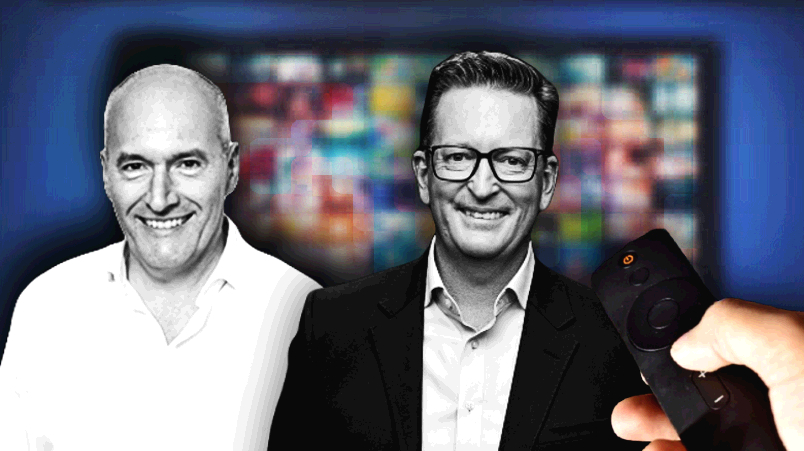
L-R: Ampere's Guy Bisson and Nine's Michael Stephenson - "Australia as a market remains stubbornly resistant to an online video advertising transition. In pretty much every other market, those lines crossed last year or the year before," says Bisson.
An Mi3 editorial series brought to you by
The Future of TV Advertising Forum and Mi3

Australia's $3bn free-to-air TV business remains “stubbornly resistant” to global TV forces which have already switched the delivery, dollars and dominance of broadcast TV to digital video in the US and UK markets. Video ad revenues on IP screens and devices abroad are now larger than the once-untouchable terrestrial and pay-TV ad markets. But hold out as they might, Australian terrestrial broadcasters are set to lose their decades-long ascendency in the ad-funded media market. By 2027 the tipping point lands here: streamed digital video will be bigger than the killer advertising channel of all time, free-to-air TV, according to the LA-based executive director of Ampere Analysis, Guy Bisson. The timeline was all but backed by Nine’s Chief Sales Officer Michael Stephenson at the Future of TV Advertising forum last week in Sydney as new research on the profile of Netflix ad tier subscribers suggests there's more duplication with online broadcaster audiences than some might hope.
What you need to know:
- Ampere Analysis predicts a tipping point where digital video will be bigger than broadcast TV by 2027.
- Nine’s Chief Sales Officer Michael Stephenson broadly backed the deadline – 2028 would likely see 9Now’s audiences overtake Nine’s free-to-air base.
- But linear TV is not dead, per Stephenson – terrestrial linear audiences, or the broadcast signal to aerials, will decline but live online streaming of linear TV programming is booming.
- The Netflix and Disney+ advertising tiers will attract 1.6 million Australian subscribers by 2027 off a total customer base of 10 million, per Ampere Analysis.
- Netflix and Stan subscribers are the least likely to take-up ad tiers of the top 10 streaming services, according to Ampere consumer research.
I suspect within five years Nine's streaming and on demand product in 9Now will be probably 50 to 60 per cent of what Nine is today.
Digital flip
It took a little cajoling but Nine’s Chief Sales Officer Michael Stephenson acknowledged in five years Australia’s biggest media group was likely to see its 9Now online platform usurp 67 years of free-to-air television.
It was a careful confirmation by Stephenson but still the first time an Australian broadcaster has staked a timeline on when nearly seven decades of terrestrial television delivered via rooftop and rabbit aerials will cede dominance to its digital streaming progeny.
"I suspect within five years Nine's streaming and on demand product in 9Now will be probably 50 to 60 per cent of what Nine is today," he said on a panel with YouTube Australian boss Caroline Oates, Foxtel Media CEO Mark Frain and Vevo's Senior Vice President, Global Revenue Operations, Natalie Gabathuler-Scully. "If we use Married at First Sight as an example, 33 per cent of the audience is consuming via a connected device today. The recent NRL launch has 25 per cent of the audience coming through 9Now." Those figures, Stephenson suggested, combined with Nine's online viewing growth and the hastening declines across FTA audiences, would trigger the digital tipping point.
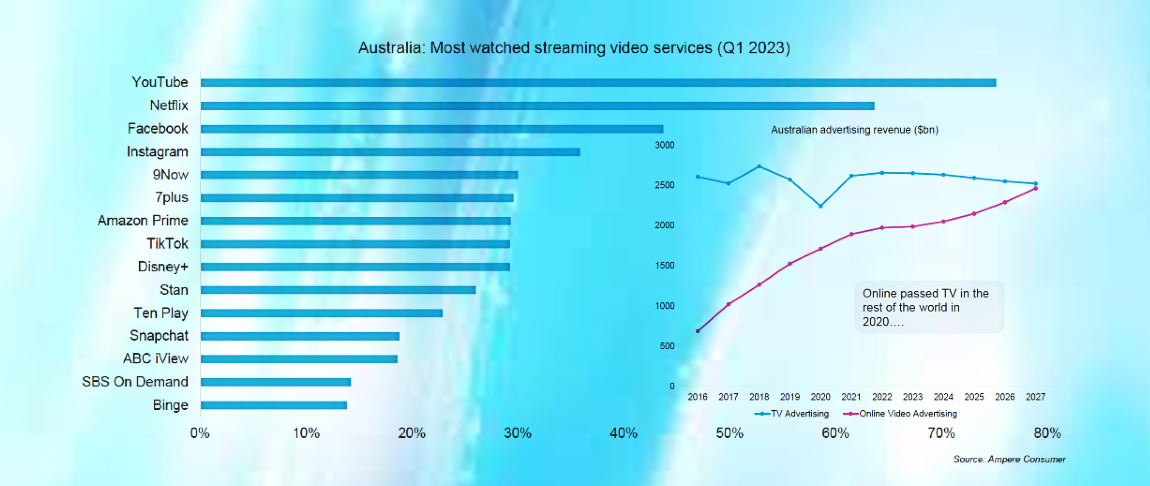
Mind your language
But Stephenson did warn on the language industry – and journalists and Mi3 panel moderators – use to define the great switch from TV delivered via a broadcast terrestrial signal to viewing on internet-connected screens. The structural shift in how TV content is delivered was not the death of "linear TV" – or even that linear was dying, he said.
"Terrestrial audiences, audiences that are being delivered by an antenna, will fragment and get smaller. But linear live streaming is not getting smaller."
It's a nuanced argument but reasonable given "linear" today includes programming that is digitally streamed and often identical to the free-to-air broadcast slate – content is curated and served by a broadcaster and the viewer takes what is served in a one-way feed. 9Now's fastest growing audiences are coming from live linear streaming on IP-delivered devices and screens.
“At some point in the future we'll have streaming only, there's absolutely no doubt about that. When that is, I don't know," Stephenson said on a Future of TV Advertising panel before acknowledging the probability of a five-year "tipping point" later in the same session. “Between now and then we have total television and that is the vehicle that will get us from one to the other.”
Measured moves
The Head of YouTube ANZ and Google Programmatic Media, Caroline Oates, also beseeched the industry on language – how could the TV industry measure "Total TV", she asked, without including YouTube – more of that in another Mi3 edition this week.
But Stephenson’s nod last week to the great digital TV switchover aligned with a forecast from Ampere Analysis, which predicted Australia will follow the US and UK by 2027, at which time local digital video revenues will surpass free-to-air, or terrestrial TV. Those international markets flipped last year, Bisson told the Future of TV Advertising forum in his keynote.
“Australia as a market remains stubbornly resistant to an online video advertising transition [from free and pay TV]," Bisson said. "In pretty much every other market those lines crossed last year or the year before."
We think about 1.6 million Australian homes will be watching the ad tiers on Netflix and Disney [by 2027] and that's about 8.5% of the customer base.
Change triggered
Globally, there is a trend toward hybrid ad-funded streaming models underway, per Bisson - which hasten the transition away from terrestrial ad dominance. "There's been a huge convergence on that middle ground of hybrid," Bisson told 600 forum delegates. "Apple is the only standout now in the entire market, at least on a global basis, who is pureplay [streamed] pay TV."
By 2027 Bisson said the terrestrial and online ad markets in Australia will be "50-50 basically ... so we're at that inflection point Australia has been so stubborn to reach. We think of that [digital video ad market], about a quarter will go to Netflix and Disney. The broadcasters will take the lion's share alongside Facebook and Google."
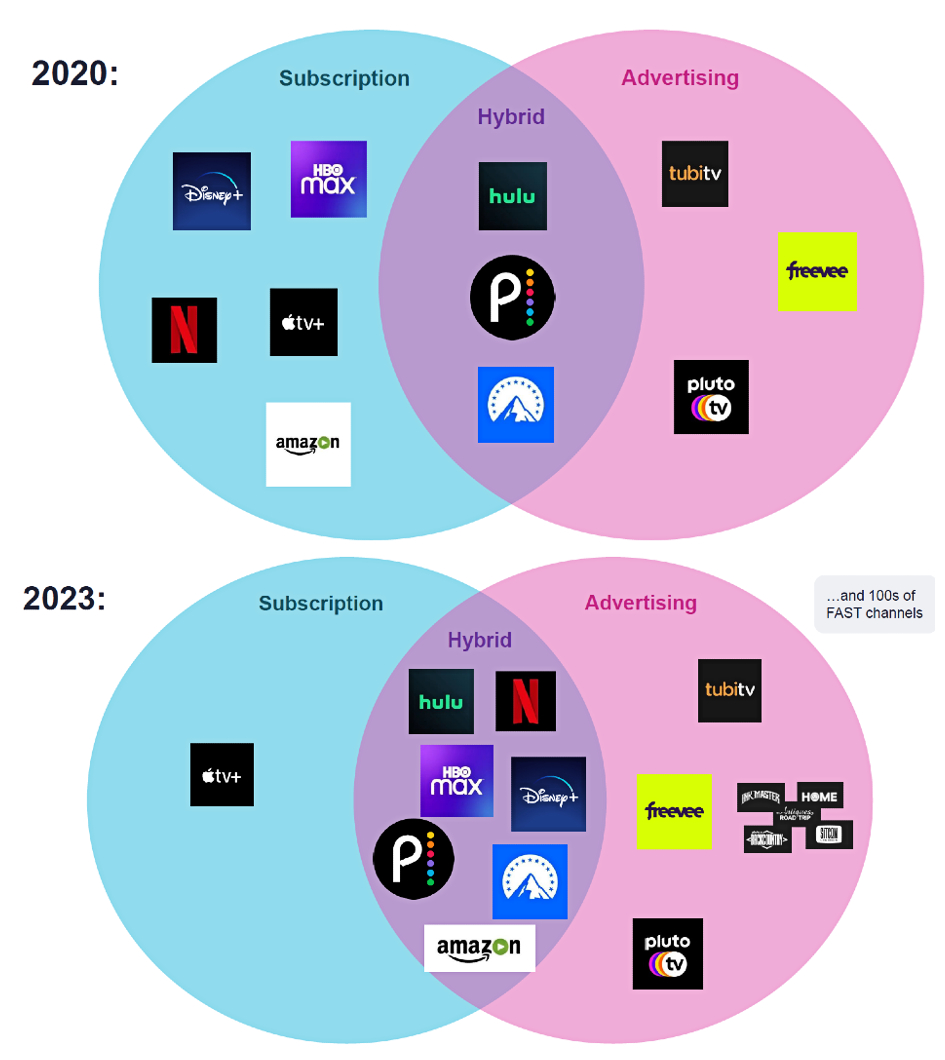
Netflix, Disney+ ad tier to hit 1.6 million
With the fanfare of Netflix launching its ad tier to its subscription line-up last year and Disney+ set to do likewise sometime this year, Ampere released the first public forecast of Australian take-up of these new ad-subsidised SVOD packages. Netflix and Disney+ between them will hit circa 10 million homes by 2027 with about 1.6 million on ad tiers, per Ampere's analysis.
"We're super early days so it's very difficult to predict but we think about 1.6 million Australian homes will be watching the ad tiers on Netflix and Disney and that's about 8.5 per cent of the customer base," Bisson said. "I call those relatively conservative forecasts but that's about the size of the addressable ad market on those global streaming platforms."
Since its November $6.99 "Basic with Ads" launch, Netflix has likely now surpassed 100,000 ad tier subscribers – media agencies each paid an estimated $6m or more for 12 months access to those new audiences on behalf of advertiser clients.
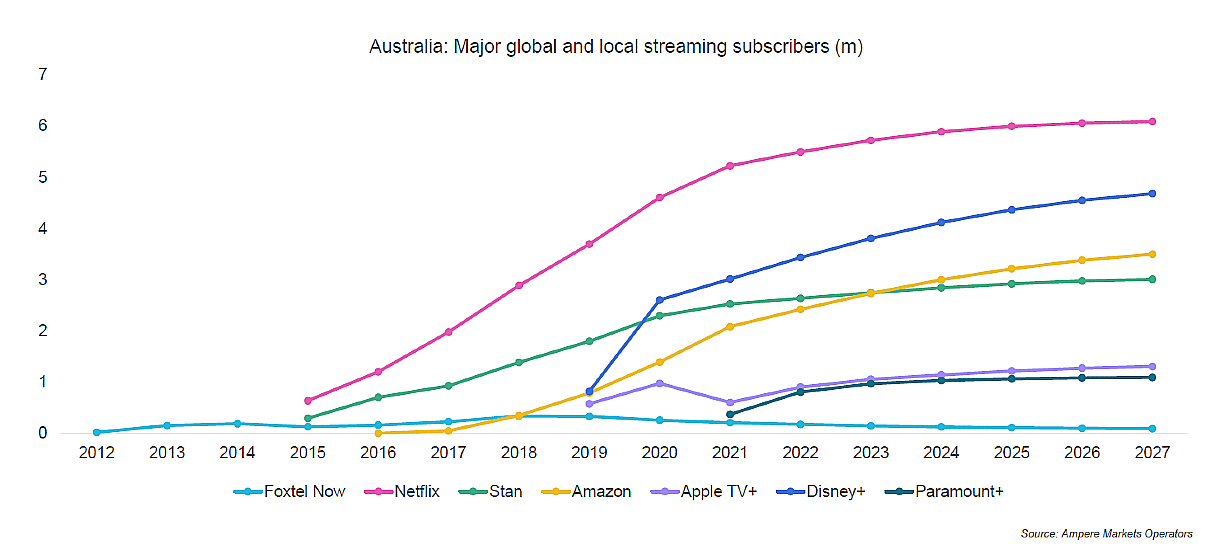
Blokes world
Ampere also released consumer research on the profile of those likely to subscribe to Netflix and Disney+ ad tiers – Bisson said the main takeout was that Netflix was "playing in the same demographic field as the broadcast streaming platforms that are currently controlling streaming advertising in this market.”
And in Ampere's consumer research Netflix and Stan were the two streaming services that people say they're most unlikely to take-up ad subscriptions to.
"It's Stan and Netflix at the bottom of the scale – so they are least likely for subscribers to want to see advertising in that top ten," Bisson said. "That means that they're being positioned in the consumer mindset as premium-like platforms. So it is true that if you think about Netflix as an advertising platform, you are not going to reach everyone. You're going to reach this very specific subset of the audience because a lot of people still perceive it alongside Stan as a very premium viewing experience and they don't want to be interrupted by advertising."
So who are those most inclined for an ad tier on Netflix?
"Firstly, they're much more likely to be male, they are 40 per cent more likely to be in their 30s or 40s, they probably have young children at home and their daily viewing is quite considerably higher than the average Australian household," Bisson said. "So the average household, by our data, reports four hours and 46 minutes of TV viewing a day. These people are watching 5 hours and 11 minutes. They already have 3.5 streaming services and they really like crime and action and sport content and then to a lesser degree, music and romance..."
Bisson acknowledged a breakout theme in his research he couldn't explain: "For some reason they really love 10Play - they are 63 per cent more likely to watch 10Play than average and I have no idea why. Perhaps because of that crime-action genre but maybe someone in the room can work that one out. It's very, very obscure." Rival broadcasters told Mi3 later that they were seeing the same findings in their consumer research about 10Play and suggest it is blokes and the crime and action genres as the driver.
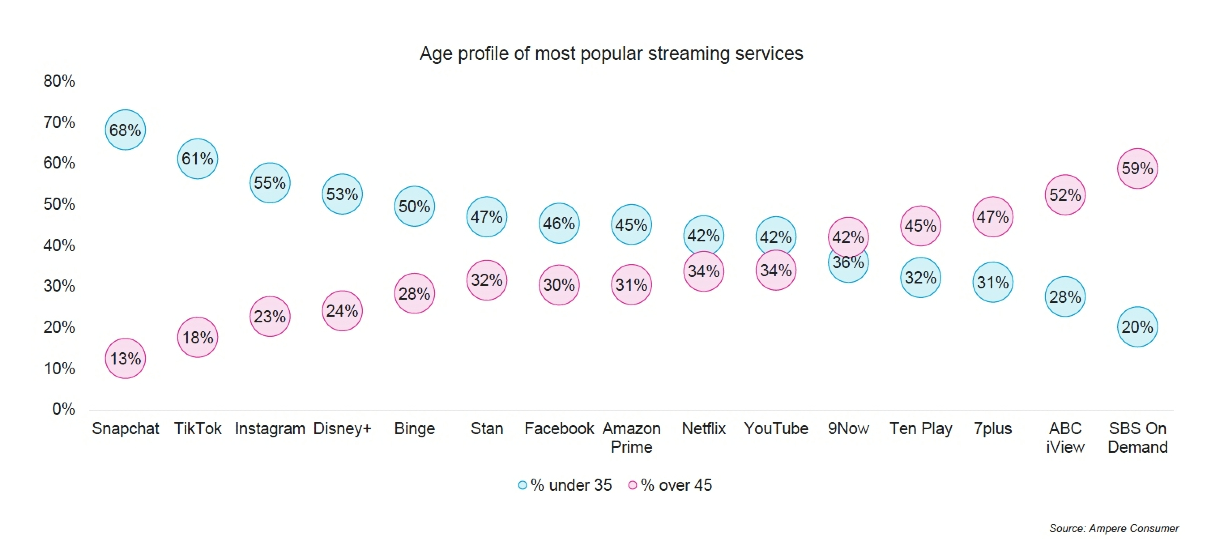
Content crossover
The final key theme in Bisson's analysis is that Covid changed the programming genres from subscription streaming services and they now collectively are pouring the same money into locally commissioned content as the broadcasters were individually.
“Streamers are spending big in Australia,” he said. "That matters for advertisers because content brings the viewers." And the programming that streamers are commissioning here is heartland broadcast TV content, further heating up the battle for audience share.
"There was a shift in strategy away from scripted dramas towards unscripted content for streaming spend and that is the bread and butter of national broadcasters – reality TV game shows, light entertainment, documentary and formatable TV programs," Bisson said.
